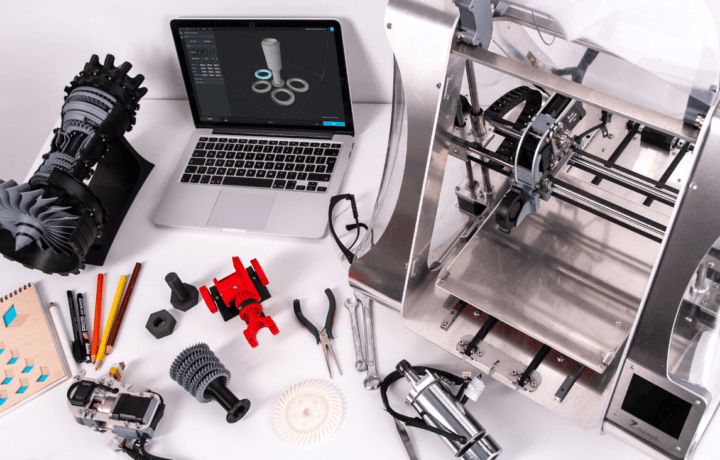One of the problems with aging military equipment is that many of the parts simply aren’t produced any longer. This is something that the United States Marine Corps has had to deal with while keeping its aging Assault Amphibious Vehicle (AAV) ready and operational. It has been used to carry Marines from ship to shore since 1972, but after nearly 50 years, it requires a lot of maintenance, which is why the Corps will phase out the vehicles in the coming years.
However, for at least the next decade, the Corps will need to keep its AAVs running. Since many of the parts aren’t being made, the Corps are doing what they do best – improvising. Instead of merely salvaging parts from out of service vehicles, the Corps has turned to 3D printing.
The Printed Military of the Future
While we’re still decades away from printing out tanks, planes, weapons or even helmets needed to arm and equip tomorrow’s warfighters, 3D printing is increasingly finding a place within the military. The Department of Defense (DoD) used 3D printers to ease the COVID-19 ventilator shortage during the still ongoing novel coronavirus pandemic.
The DoD has used 3D printing for a variety of projects over the years. Engineers at Aberdeen Proving Ground in MD produced parts for unmanned aerial and ground vehicles and weapon systems, including the 40mm grenade launcher. Army researchers at Picatinny Arsenal in NJ even produced a turret for an M1A1 Abrams tank – a process that would normally require a giant lathe.
3D printing has also been used to create mockups of parts for aircraft carriers – streamlining the production efforts as more traditional methods using wood or metal to make the models would have taken far more time and labor. In recent years, the use of 3D printing has gone from mockups to actual products. The U.S. Navy’s Fleet Readiness Center developed an enhanced hydraulic intake manifold for the V-22 Osprey. It was 70% lighter and even improved fluid flow.
3D Printing in Action in the Marine Corps
The Marine Corps are now relying on HP Metal Jet 3D printing to produce hundreds of replacement parts, including bolts, mounts, brackets, cranks and couplings.
“This is a critical part of our future, ensuring readiness of those in uniform,” said Kristin Holzworth, chief scientist for the Advanced Manufacturing Operations Cell, part of the Marine Corps Systems Command.
“3D printing is poised to replace the traditional supply chain for the defense industry,” explained Edwin Pope, principal Analyst within the Supply Chain and Technology group of IHS Markit.
“A few pilot programs have been initiated through Army, Navy, and Air Force,” Pope told ClearanceJobs. “I expect Space Force will follow suit. Component repair and production is not unfamiliar to any of these branches of service when looking back to the various forms of machine shops used by each branch.”
The Additive Process – How it WOrks
3D printing differs from traditional manufacturing in a few ways. As HP and the Corps noted, traditionally many AAV parts were made with “subtractive manufacturing,” which is a process that begins with a solid block of material that slowly gets sliced away to create a specific shape. In contrast, the HP Metal Jet printers precisely place up to 630 million nanogram-sized drops per second of a liquid binding agent onto a powder bed, forming the part layer by layer. The water-based liquid is made with a polymer that binds the metal particles together.
When it is heated or cured it leaves a solid, high-strength part.
“Metal Jet is big advantage to us,” explained Col. Tucker, commanding officer of Combat Logistics Regiment 15 at Camp Pendleton, California, where Marines train in AAVs. “Being able to clasp (what used to require) 50 different, subtractive-manufacturing lines into a couple of prints, you almost can’t even put words to that. The efficiencies that are likely to come from that are absolutely astronomical.”
3D printing can be used beyond just making identical parts that are truly interchangeable, as it can also create customized equipment. Last month the U.S. Army Aeromedical Research Laboratory used the 3D printing process to produce and test customizable earplugs for members of the U.S. Armed Forces.
Contractor Relations
This technology could also enable smaller players as well as those in other sectors to compete for government contractors. HP has been a powerhouse for printing, but is hardly in the league of Boeing or Lockheed Martin when it comes to defense contracts.
“I expect the contractor and support infrastructure will closely model existing relationships,” said IHS Markit’s Pope. “Equipment purchases at higher command levels will most likely contain a training agreement and service member level repairs/troubleshooting will be established as standards. For levels above, FSRs will most likely be required. I also believe that there may be a bit of room for contract level specialists to bridge the gap in skill proficiency while each branch of service develops their own MOS and training models.”
This could also bring new opportunities for those with 3D printing experience to work with those contractors. Pope plans to look to contractors for scheduled maintenance, calibration, retrofits, training, and major component replacements.




